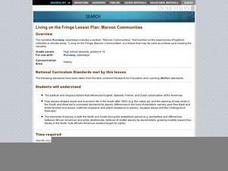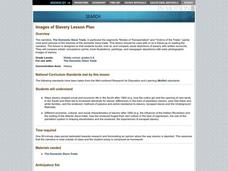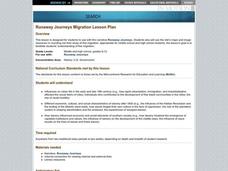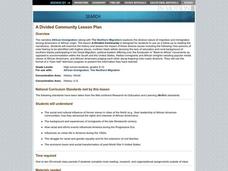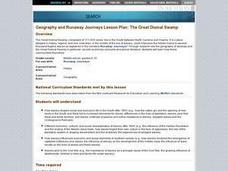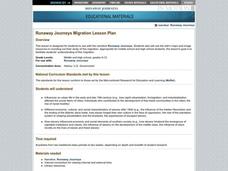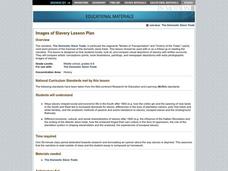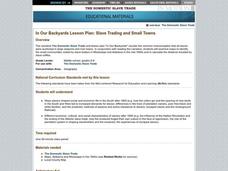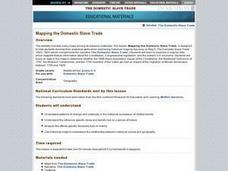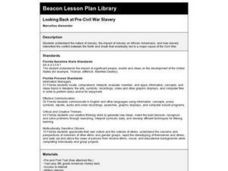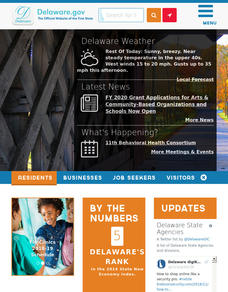Curated OER
What Happened to Slaves When their Owners Died?
Young scholars analyze last and testaments of former slaveowners to identify and explain economic, social and cultural differences between the North and the South leading up to the Civil War.
Curated OER
Underground Railroad
Fourth graders use internet cites to explore the Underground Railroad. They also learn the importance of the Emancipation Proclamation. Focus questions are included.
Curated OER
Maroon Communities
Students examine political and religious factors that influenced English, Spanish, French, and Dutch colonization of the Americas, how slavery shaped social and economic life in the South after 1800, and elements of slavery during the...
Curated OER
Images of Slavery
Learners analyze the ways slavery shaped social and economic life in the South after 1800, methods of passive and active resistance to slavery; escaped slaves and the Underground Railroad, and the ending of the Atlantic slave trade.
Curated OER
RUNAWAY JOURNEYS MIGRATION
Students analyze the influences on urban life in the early and late 19th century, different economic, cultural, and social characteristics of slavery after 1800, the rise of racial hostility, and the ending of the Atlantic slave trade.
Curated OER
A Divided Community
Students work in teams to research the history of African migration and immigration in the U.S. They present their research in a town hall discussion format and then write a paragraph about their experiences.
Curated OER
THE GREAT DISMAL SWAMP
Students analyze how slavery shaped social and economic life in the South after 1800, the different economic, cultural, and social characteristics of slavery after 1800, and slavery both prior and after the Civil War.
Curated OER
Fugitive Slave Narratives
Middle schoolers analyze the ways slavery shaped social and economic life in the South after 1800, the different economic, cultural, and social characteristics of slavery after 1800, and the ending of the Atlantic slave trade.
Curated OER
Three Coffles Lesson Plan
Students read about the slave trade in primary source documents. They discuss differences and commonalities in experiences. They write prose or poetry from the point of view of one of the figures from the reading and create a triptych.
Curated OER
Amistad
Seventh graders explain the predicament of the slaves on the Amistad and the conditions that led them to revolt against their captors. After watching the movie 'Amistad,' students engage in a class discussion based on what they saw.
Curated OER
Mapping the Many Underground Railroads
Students plot the migration route of one of the runaway slaves named in a narrative and add it to a map of the United States in 1850. This is an excellent lesson on the Underground Railroad!
Curated OER
Runaway Journeys Migration
Students use the Runaway Journeys site maps and image resources in rounding out their study of the slave migration. They access an excellent multi-media narrative imbedded in this plan.
Curated OER
The Deadly Equilibrium
Young scholars determine if the economic model of slavery in the United States could or could not survive without expansion of slavery to the western territories. They access an excellent multi-media narrative imbedded in this plan.
Curated OER
Images of Slavery
Students locate, examin, and compare visual depictions of slavery with written accounts. They compare artists' conceptions (prints, book illustrations, paintings, and newspaper depictions) with early photographic images of slavery.
Curated OER
Slave Trading and Small Towns
Learners examine maps to identify the small communities visited by slave traders in Mississippi and Alabama in the mid-1840s and to calculate the distance traveled by slave coffles.
Curated OER
Whitewashing the History of the South
Students research online a variety of different plantation museums across the South to ascertain how realistically, if at all, slavery is portrayed. This is a very interesting way for students to see how history can be presented in many...
Curated OER
Mapping the Domestic Slave Trade
Students develop their analytical skills when examining historical maps. They examine a map for data which supports textual information about the Constitution, Congressional legislation, and the historic U.S. economy.
Curated OER
Seeking Liberty Lesson Plan: Runaways' Emigration Out of the United States
Students read the narrative, Runaway Journeys, and examine other countries' policies towards fugitive slaves from the U.S. They research the laws from various countries, and write a five-paragraph essay.
Curated OER
Looking Back at Pre-Civil War Slavery
Eighth graders explain the nature of slavery, the impact of slavery on African-Americans, and how slavery intensified the conflict between the North and South that eventually led to a major cause of the Civil War.
Curated OER
Counting the Miles To Freedom
Learners research Harriet Tubman via an Underground Railroad website in cooperative groups. They identify Tubman's first route to freedom and organize information gleaned from the research in a visual display (created in KidPix.)
Curated OER
Literacy & Art: The Story behind the Quilt
Students examine the many ways quilts were used to chronicle the history and experiences of African slaves and African-Americans in America. They analyze a story quilt using the elements of storytelling, then create a class quilt.
Curated OER
Why Did Delawareans Use Slaves?
Students read about an indentured servant, and complete a chart comparing slaves and indentured servants.
Curated OER
Fugitive from Labor Cases:
High schoolers examine the cases of Henry Garnett and Moses Honner, both of the 1850s. Students analyze the political climate building up to the Civil War through the lens of these similar cases with different outcomes.
Curated OER
Slavery
Students trace the routes of escaping slaves on their journey north by calculating the mileage each one walked and define and use accurately the term Underground Railroad. They read The Drinking Gourd by Jeanetter Winter.




